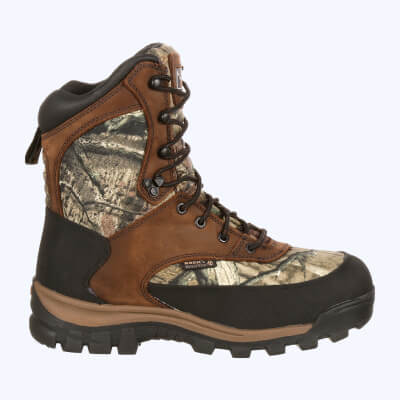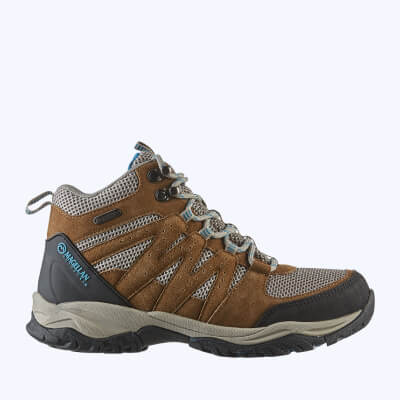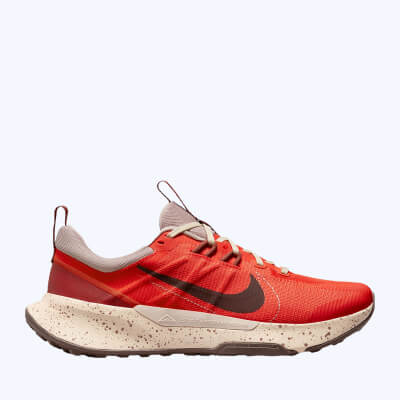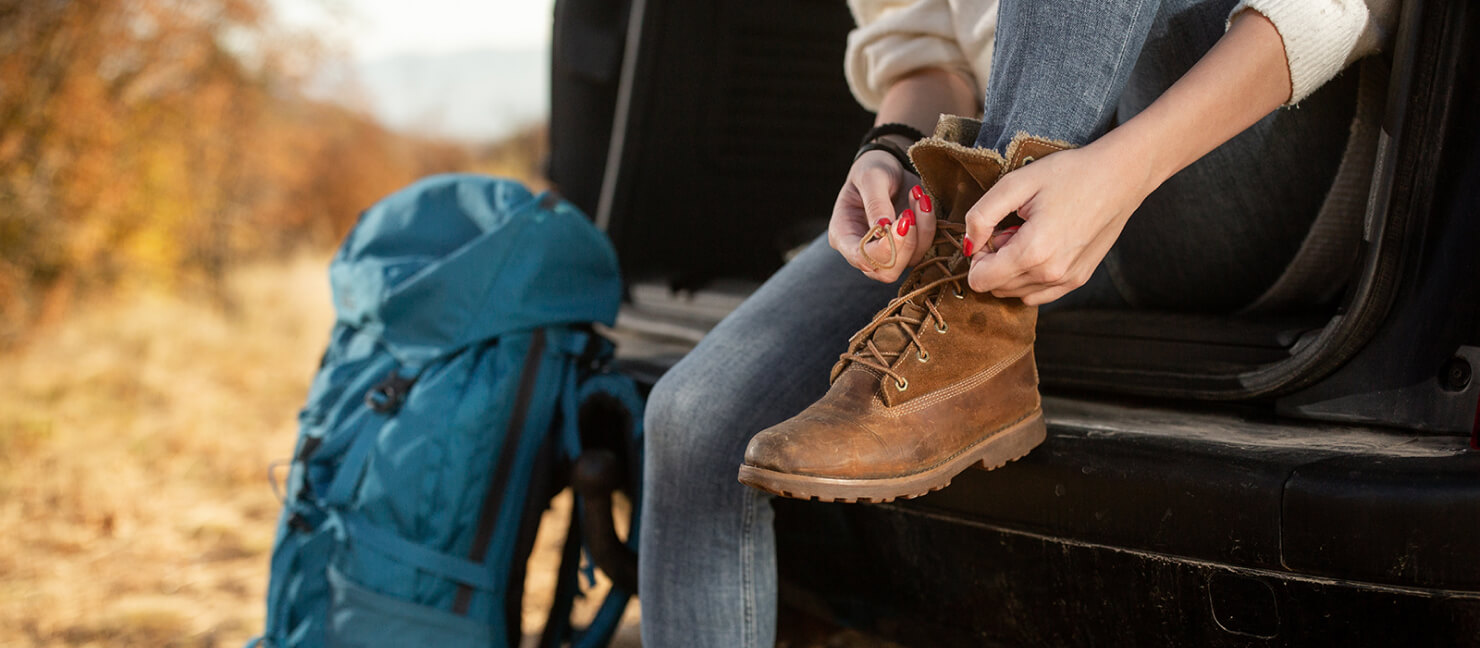How to Choose Hiking Boots: Fit, Materials, & More

When it comes to hiking boots, cut, material, features, and comfort can make or break your hiking experience. Whether you're a seasoned trekker or a novice explorer, finding the ideal pair is the first step toward a memorable and fun outdoor adventure. In this guide, you’ll learn all about how to choose the perfect pair of hiking boots.
Key Takeaways
- How to Choose Hiking Boots: Decide between hiking boots, hiking shoes, or trail runners. Select either a low-cut, mid-cut, or high-cut hiking boot and choose waterproof materials and comfort features geared for the type of hiking you’ll be doing.
- How Should Hiking Boots Fit? Hiking boots should offer enough room for your toes while ensuring a secure fit. Your ankles shouldn’t slip out of them or feel too roomy.
- Find Your Size With Our Hiking Boot Size Charts: Locate your hiking boot size using our charts for men, women, children, or youth.
- Problems With Fit for Hiking Boots: Blisters, heel pain, pinched toes, and leg soreness indicate that your hiking boots may not be the correct size. You may need to return to the store to get your feet resized or try a different brand.
How to Choose Hiking Boots
-
Step 1: Know which hiking boots or shoes you need —Hikers use trail runners for running on hiking paths, hiking shoes for casual hikes, and hiking boots for slippery trail conditions.
-
Step 2: Match your hiking type and footwear — Your hiking boots need to offer adequate support for the trail’s conditions. High-cut hiking boots excel on longer hikes, while low-cut hiking boots are ideal for day hikes.
-
Step 3: Prioritize comfort + fit — Comfortable, well-fitting boots are essential to prevent injuries. Avoid discomfort and pressure points by using arch support and by breaking them in over 2-4 weeks.
-
Step 4: Consider the Materials + Features — Seek out features like waterproof membranes to tackle puddles, shock-absorbing midsoles for comfort during long hikes, and reliable traction on the boot's sole to prevent slipping.

Know Which Hiking Boot or Shoe You Need
We can divide hiking footwear into three categories: hiking boots, hiking shoes, and trail runners. Each category serves specific purposes — from running to conquering rugged terrain. Explore the distinctions between these categories below.
Hiking Boots

Hiking boots provide stable support, insulation, and various features to aid you on your hikes. Hiking boots commonly have uppers made out of leather.
- Waterproof Construction: A waterproof construction ensures your feet stay dry even in the wettest conditions. This makes them suitable for hunting and other outdoor activities.
- Durable Outsoles: Hiking boots should have grippy treads to prevent slipping. Manufacturers commonly use materials like rubber to provide flexibility for the outsoles.
Hiking Shoes

Hiking shoes offer the flexibility of walking shoes with the added ankle support found in hiking boots. Manufacturers typically avoid insulating these shoes.
- Comfort: Hiking shoes offer a cushioned midsole for support. This comfort comes in handy for hikes between 2-10 miles.
- Ankles Support: Hiking shoes can cover your ankle for increased stability. Hiking boots are ideal for day hikes on slippery or more challenging terrain.
Trail Runners

Trail runners tend to have a shorter breaking-in period than traditional hiking boots. They offer midsole support so you can run on hiking trails in the woods and mountains.
- Outsoles: The outsoles on trail runners range from light to more substantial grip. Some trail runners have tapered lugs for increased traction.
- Toe Protection: Some trail runners have thick skin across the toes. This helps in protecting the toes from sharp twigs or rocks.
Match Your Hiking Type and Footwear
Your hiking shoe should support all the gear you’ll carry on long miles. Make sure your hiking boot cut aligns with your hiking type.
-
Type of Hike: Your hiking boots should suit the technical level you’ll encounter on your hike. For casual day hikes, opt for hiking shoes. Longer hikes require more support, such as mountaineering boots.
-
Hiking Boot Cut: Consider different hiking boots available, such as low-cut, mid-cut, and high-cut options. Low-cut boots are perfect for casual hikes, mid-cut boots suit technical terrain, and high-cut boots are designed for backpacking and challenging conditions.
Check out our table below to narrow down your hiking boot options based on the hiking difficulty you’ll encounter and the boot support you’ll need.
| Hiking Boot Style Guide: Low, Mid, & High-Cut | ||
|---|---|---|
| Hiking Boot Cut | Description | Best Use |
| Low-Cut | Lighter weight, offers ankle freedom and less support. | Ideal for shorter day hikes and suitable for trail running. |
| Mid-Cut | Lays on the ankle bone and provides stability and support. | Geared toward more technical hikes. |
| High-Cut | Offers maximum security and stability. Covers the ankle completely, offering ample support. | Suited for long hikes with added weight or gear, such as backpacking. |
Prioritize Comfort + Fit
Blisters or plantar fasciitis (inflammation on the bottom of the foot and heel) can quickly turn your hike into a nightmare. Always prioritize comfort over fancy features. A comfortable fit is essential for an enjoyable hiking experience.
-
Break Your Boots In: Take 2-4 weeks to slowly break in your hiking boots. Wear your boots indoors with hiking socks. You can also try conditioning the leather, getting your boots wet, and adjusting the laces for a better fit.
-
Shop In-Person: Shop for hiking boots in person whenever possible. Trying on different sizes and styles and walking around in them will help you find the perfect fit.

Consider the Materials + Features
When selecting hiking boots, focus on the materials used in the upper part of the boot, midsole, and outsole. Look for a boot that offers internal support and reliable traction on the bottom to ensure stability and comfort. Look for additional features such as:
-
Waterproof Membrane: Some boots feature a waterproof membrane that prevents water from seeping. This keeps your feet dry even when you encounter puddles or streams.
-
Insulation: Insulated boots provide extra warmth, making them suitable for colder conditions. Sheepskin lining can be used for freezing conditions.
| Common Hiking Boot Components + Materials | ||
|---|---|---|
| Category | Description | Materials/Types |
| Uppers | The upper part of the boot covers the top of the foot. It affects durability, breathability, and water resistance. | Leather (full-grain, split-grain), Synthetics (nylon, polyester), Waterproof membranes |
| Midsoles | The layer between the insole and the outsole provides cushioning, support, and shock absorption. | EVA (ethylene vinyl acetate) for softer cushioning or PU (polyurethane) for firmer support |
| Insulation | Added to boots to keep feet warm in cold conditions. Important for winter hiking or mountaineering. | Synthetic insulation (Thinsulate, PrimaLoft)or Felt and sheepskin linings (for extreme cold) |
| Internal Support | Structures within the boot that provide support to the foot and ankle. They can help with balance and prevent the foot from rolling. | Shanks (inserted between the midsole and outsole) or plates (thin, semiflexible inserts) |
| Outsoles | The bottom part of the boot that makes contact with the ground. It affects traction, grip, and stability. | Rubber (varies in hardness), Lugs for traction, Heel brake to reduce slipping on descents |
When shopping for hiking boots, prioritize a proper fit that suits your needs. Ensure the toe box fits comfortably, and check for sufficient grip on the outsole. Familiarize yourself with the hiking boot's anatomy from top to bottom.

How Should Hiking Boots Fit?
You should be able to slide your index finger into the back of your shoe. Ensure your heel doesn't lift excessively or make you walk out of the boots. Your hiking boots should feel snug but not too tight, giving you a comfortable fit.When trying on hiking boots, wear the same hiking socks you intend to use on your hikes. Experiment with various boot styles to gauge their feel and fit. Ensure your toes have enough room — especially for downhill descents and avoid boots that pinch anywhere.
Expert Tip:
Feet can swell as the day progresses — typically reaching their largest size later in the evening. It's a good idea to shop for hiking boots during this time to ensure a better fit for your feet.
Measure Your Feet in Millimeters

You can measure your feet at home either alone or with a friend. Since manufacturers may have different sizing standards, trying on multiple sizes can help you find the closest fit. You can measure your foot width to determine whether you need a narrower or wider fit. Keep reading for step-by-step directions.
-
1: Place a blank sheet of paper against a wall or other 90° surface.
-
2: Place your heel against the wall on a flat, level surface.
-
3: Mark the endpoint of the longest toe with a pen or pencil.
-
4: Measure both feet in millimeters. Use the larger measurement.
-
5: Compare your measurement to our size charts. Use the closest larger measurement to determine your size.

Find Your Size With Our Hiking Boot Size Charts
Finding the perfect hiking boots for your adventures can be challenging, especially when shopping for the whole family. Lightweight hiking shoes are a versatile choice for kids.
Adult hiking boots provide the necessary cushioning and support for adults tackling more rugged terrain and carrying additional gear. To determine the correct sizes and the appropriate hiking boot style for your needs, refer to the sections below:
Find Hiking Boot Sizes for Men
Men’s hiking boots offer additional ankle support, a wider fit, and are heavier. Most boots are available in muted, earth-colored tones.
| Men’s Hiking Boot Size Chart | |
|---|---|
| Millimeters | Shoe Size |
| 243.0 - 247.0 | 7 |
| 247.0 - 251.0 | 7.5 |
| 251.0 - 256.0 | 8a |
| 256.0 - 260.0 | 8.5 |
| 260.0 - 264.0 | 9 |
| 264.0 - 269.0 | 9.5 |
| 269.0 - 273.0 | 10 |
| 273.0 - 277.0 | 10.5 |
| 277.0 - 281.0 | 11 |
| 281.0 - 285.0 | 11.5 |
| 285.0 - 290.0 | 12 |
| 290.0 - 298.0 | 13 |
| 298.0 - 307.0 | 14 |
| 307.0 - 315.0 | 15 |
| 315.0 - 324.0 | 16 |
Find Hiking Boot Sizes for Women
Women's hiking boots are typically lighter and narrower than men's. We offer popular brands such as Adidas, Magellan Outdoors, and more.
| Women’s Hiking Boot Size Chart | |
|---|---|
| Millimeters | Shoe Size |
| 218.0 - 222.0 | 5 |
| 222.0 - 226.0 | 5.5 |
| 226.0 - 231.0 | 6 |
| 231.0 - 235.0 | 6.5 |
| 235.0 - 239.0 | 7 |
| 239.0 - 243.0 | 7.5 |
| 243.0 - 247.0 | 8 |
| 247.0 - 251.0 | 8.5 |
| 251.0 - 256.0 | 9 |
| 256.0 - 260.0 | 9.5 |
| 260.0 - 264.0 | 10 |
| 264.0 - 269.0 | 10.5 |
| 269.0 - 273.0 | 11 |
| 273.0 - 281.0 | 12 |
Find Hiking Boot Sizes for Children
Knowing your children's shoe size in advance can ensure that you're on the right track. Children's shoe sizes typically cover ages 1-7 years old in most cases.
| Children’s Hiking Boot Size Chart | |
|---|---|
| Millimeters | Shoe Size |
| 108.0 - 112.0 | 4 |
| 112.0 - 121.0 | 5 |
| 121.0 - 129.0 | 6 |
| 129.0 - 138.0 | 7 |
| 138.0 - 146.0 | 8 |
| 146.0 - 155.0 | 9 |
| 155.0 - 163.0 | 10 |
| 163.0 - 171.0 | 11 |
| 171.0 - 180.0 | 12 |
| 180.0 - 188.0 | 13 |
Find Hiking Boot Sizes for Youths
Ensure there's roughly half an inch of space at the toe for your growing child. Youth hiking boot sizes typically apply to ages 8 and up.
| Youth’s Hiking Boot Size Chart | |
|---|---|
| Millimeters | Shoe Size |
| 188.0 - 197.0 | 1 |
| 197.0 - 205.0 | 2 |
| 205.0 - 213.0 | 3 |
| 213.0 - 222.0 | 4 |
| 222.0 - 231.0 | 5 |
| 231.0 - 239.0 | 6 |
| 239.0 - 247.0 | 7 |
Problems With Fit for Hiking Boots
Fitting issues with hiking boots can lead to common problems like heel pain, leg soreness, blisters, pinched toes, and arch discomfort. Here's how to address these issues:
-
Size Adjustment: If you are experiencing pain or pinched toes, you may need a new size. You can also experiment with wearing thinner or thicker hiking socks.
-
Wider Boots: If you notice blisters on your feet after a long hike, opting for wider hiking boots can provide relief. Wider boots can also be helpful for pinching.
-
Arch Support and Inserts: You can alleviate leg soreness or arch pain by using arch support or specialized inserts. Inserts can help stabilize your feet for more technical hikes.
-
Extra Socks + Moleskin: While hiking, carrying extra socks is a good practice to keep your feet dry and reduce friction. Carry moleskin to prevent blisters, and give your feet plenty of rest to aid recovery during your hike.

Have Fun Out There!
Planning a hike? Prepare with the perfect pair of hiking boots. At Academy, we offer a wide range of boots, including trail runners and hiking shoes, to help you conquer steep inclines and savor breathtaking views. And don't miss out on our selection of hiking gear to ensure you have a memorable outdoor experience!
 Gift Cards
Gift Cards Big Fun Deals
Big Fun Deals Hot Deals
Hot Deals Clearance
Clearance

